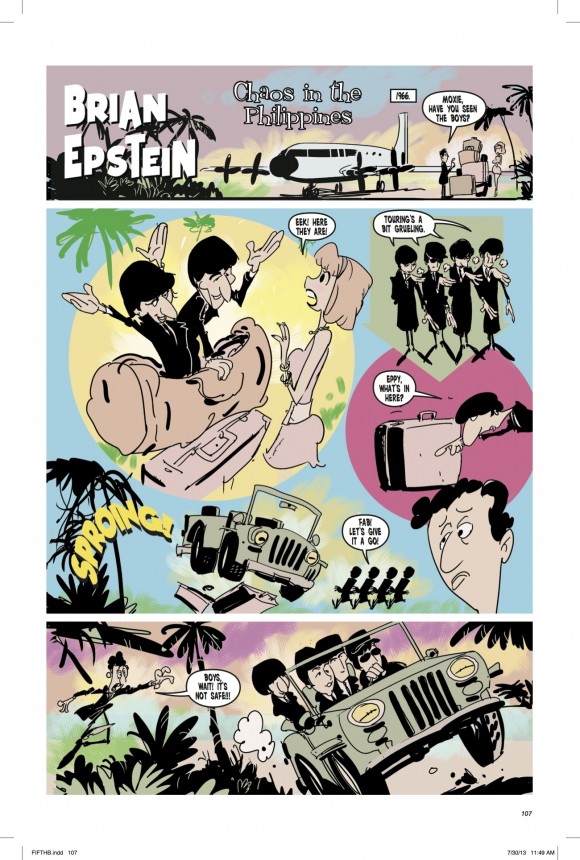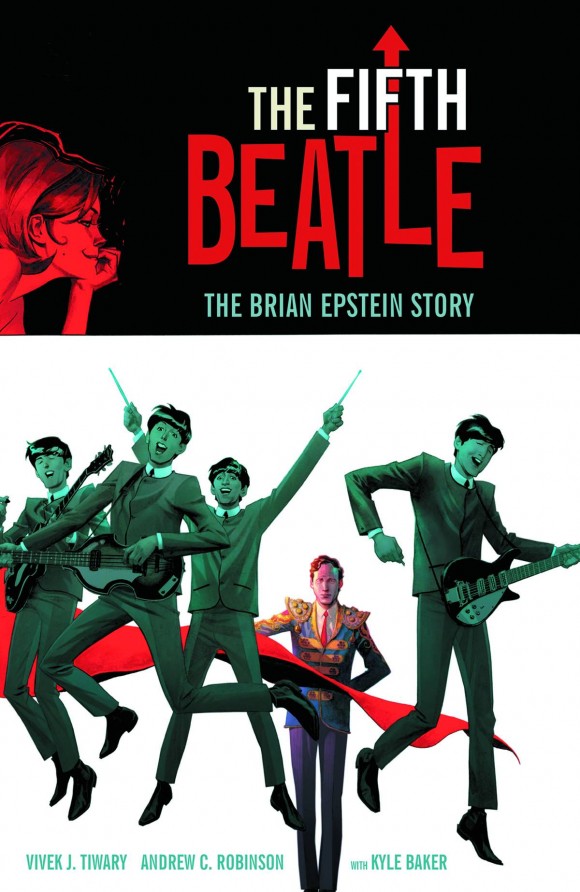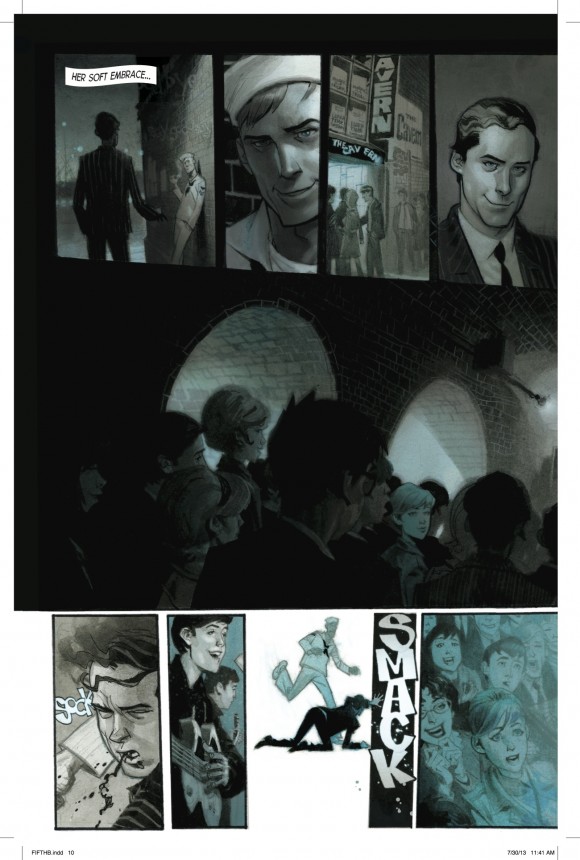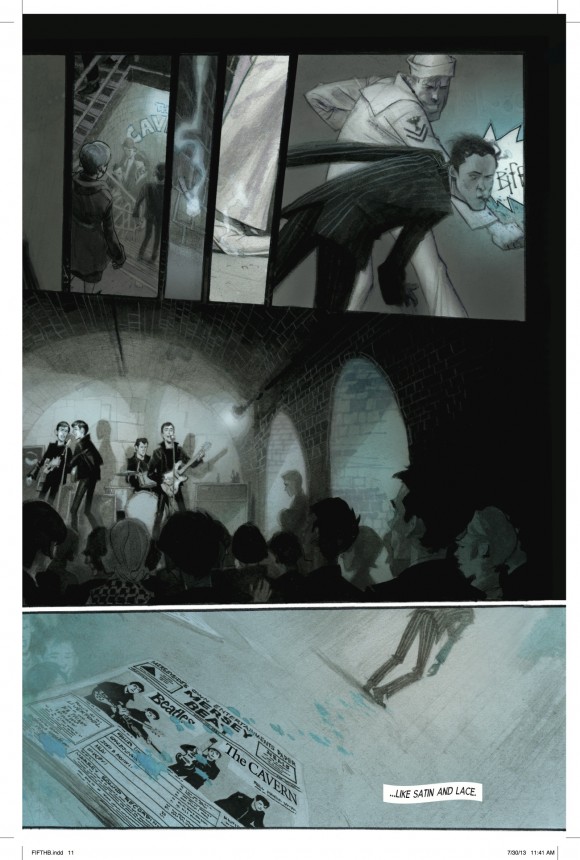13th Dimension is proud to host Vivek J. Tiwary, who stops by with an exclusive essay on the nexus of art and music in the new Dark Horse graphic novel, “The Fifth Beatle: The Brian Epstein Story.”
A symphony of color.
That’s how my friend, the brilliant artist Ramón Pérez, described one aspect of his approach to the art in his monumental graphic novel “A Tale of Sand.” I love the phrase, because it is at once poetic and yet practical and specific. And it’s exactly how Andrew C. Robinson, Kyle Baker and I approached the artwork in “The Fifth Beatle: The Brian Epstein Story.”
Ramón was adapting Jim Henson’s screenplay for a movie that was never filmed. The screenplay had very little dialogue — it’s almost a silent movie. Of course, no silent films were truly silent; they usually had some form of musical accompaniment (before the days of film sound, musicians were set up in the cinema). But since Henson didn’t leave any music queues, Ramón had to envision his own personal score and use art and color to convey his own private symphony. He had his work cut out for him — but the end result is breathtaking.
Andrew, Kyle, and I also had our work cut out for us with “The Fifth Beatle” — but we had almost the reverse challenge as that presented by “A Tale of Sand.” While Ramón had to come up with his own music queues, Andrew and Kyle had to craft their artwork to convey some of the most recognizable songs on the planet — Beatles hits! Their symphonies of color had to make our readers hear “All You Need Is Love,” “You’ve Got to Hide Your Love Away” and so on. As the book’s writer, I often gave Andrew and Kyle very specific music queues — for example, Kyle’s sequence “Chaos In the Philippines” is set to the song “Help!” It’s an unenviable task I gave them — but much like Ramón’s work in “A Tale of Sand,” Andrew and Kyle’s art in “The Fifth Beatle” simply takes my breath away.
When I first started structuring the script for “The Fifth Beatle: The Brian Epstein Story,” I immediately thought of music and color palette. The story begins in 1961 Liverpool — industrial, rainy, dark, depressing. Almost black and white, muted and monotone. Brian Epstein, a gay, Jewish man from Liverpool (three significant obstacles to success to say the least) discovers an unknown band in a basement cellar, and immediately his black and white world is infused with the possibilities of endless color.
Brian offers to manage the band and eventually gets the Beatles a record deal after every company in the music industry rejects them. He comes up with the famous Beatles suits, haircuts, and performance-ending bows. He twists Ed Sullivan’s arm into booking them at a time when no British band had ever made an impact in the US (initially, Sullivan viewed the Beatles as a “novelty act”). Brian later convinces their record label to let the Beatles experiment with new sounds and artistic structures. And by the time the story ends, we are in 1967 London — the Summer of Love, the dawn of the psychedelic era. A Technicolor dream.

Dan here: Doing this sequence in the style of the forgotten Beatles TV cartoon was brilliant! Art by Kyle Baker. (Previous pages by Andrew C. Robinson)
From the very first days of scripting, I envisioned the arc of the Brian Epstein story as a combination of the arc of the movement from black and white to Technicolor with the arc of the movement from “Love Me Do” to ”A Day In The Life.” I know that sounds awfully confusing and pretentious. So I’ll put it more simply — the arc of “The Fifth Beatle” is a symphony of color.
I’m often asked why I chose the graphic novel medium to tell the Brian Epstein story, and there’s your answer — “The Fifth Beatle” is a symphony of color. The two media that best convey such a lovely and delicate thing are graphic novels and films. Not coincidentally, we also have a “Fifth Beatle” film in active development, for which we’ve secured unprecedented Beatles’ music rights — you can expect more symphonies of color there. So I hope when you read “The Fifth Beatle: The Brian Epstein Story,” you’ll not only discover an inspiring true story about a man who against all odds realized a spectacular dream — but you’ll see, hear, and feel a complex symphony of color.
Vivek J. Tiwary
New York City, 2013
—
From Dan: “The Fifth Beatle” comes in three different formats. For more info, click here.




Trackbacks/Pingbacks